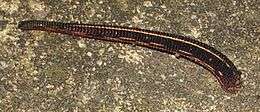Euhirudinea
Euhirudinea, the true leeches, are an infraclass of the Hirudinea. These clitellate annelids are of somewhat unclear relationships; namely the relationships of Hirudinea with oligochaetes are in need of revision. It may be that the presumed sister taxon of the Euhirudinea, the Acanthobdellidea, turns out to be more distantly related, as was already the case with the Branchiobdellida. Thus, eventually Euhirudinea might become a junior synonym of Hirudinea.
| True leeches | |
|---|---|
 | |
| A true leech in a Sydney suburb | |
| Scientific classification | |
| Kingdom: | Animalia |
| Phylum: | Annelida |
| Class: | Clitellata |
| Subclass: | Hirudinea |
| Infraclass: | Euhirudinea |
| Orders | |
True leeches are subdivided into two groups, the Arhynchobdellida or Arhynchobdellae (proboscisless leeches), and the Rhynchobdellida or Rhynchobdellae (jawless leeches). Note that the lack of jaws is a plesiomorphy, while the presence of a proboscis is an apomorphy - not all Arhynchobdellida have jaws, but all Rhynchobdellida have a proboscis. The most well-known leech species, Hirudo medicinalis (European Medical Leech), belongs to the Arhynchobdellida.
Euhirudinea leeches tend to hunt for nutrients in the morning, or afternoon. This is significant because leeches that hunt in the morning are found in largers sizes than those who hunt in the afternoon. Therefore, morning feeding seems to be more nutritious for the leeches than those who feed during the afternoon. Furthermore, these leeches are found either on trail, or off-trail, this is important for there had been found a greater amount of leeches that are found off-trail, than those that are on-trail.
| Wikispecies has information related to Euhirudinea |
References
Gąsiorek, Piotr & Różycka, Hanna. (2017). Feeding strategies and competition between terrestrial Haemadipsa leeches (Euhirudinea: Arhynchobdellida) in Danum Valley rainforest (Borneo, Sabah). Folia parasitologica. 64. 10.14411/fp.2017.031.